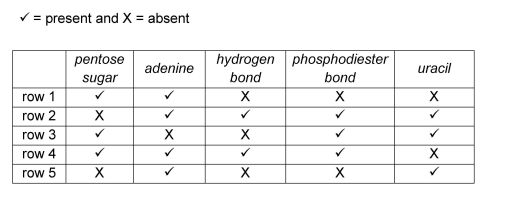Which row of the table correctly indicates features that are found in both pure extracts of DNA and tRNA molecules?

A. row 4
B. row 1
C. row 5
D. row 3
E. row 2
Which row of the table correctly indicates features that are found in both pure extracts of DNA and tRNA molecules?

A. row 4
B. row 1
C. row 5
D. row 3
E. row 2
The correct answer is A.
Let’s review what DNA and tRNA molecules are made of.
Pentose sugar, adenine and uracil
First, both DNA and RNA are made of ribose (or deoxyribose in the case of DNA), which is a type of sugar. Ribose is a pentose sugar : it is made of 6 carbon atoms.
Therefore, both molecules contain a pentose sugar.
First, there are 4 types of nucleotides (or bases) : adenine, cytosine, thymine and guanine. Each of them are represented by a letter, respectively A, C, T, G.
These bases form pairs and are the building blocks of nucleic acids, such as DNA or RNA. In the case of RNA, thymine is replaced by uracil (U), through a process of demethylation.
Uracil is NOT present in both molecules, but adenine is.
Hydrogen and phosphodiester bonds
Adenine and thymine (or uracil) can form pairs and are bonded by 2 hydrogen bonds
Guanine and cytosine can form pairs and are bonded by 3 hydrogen bonds
Therefore, row 4 is the one that best describes the features present in pure DNA and tRNA molecules.
It is strange, but in 26th question of 2016 imat past paper, is assured that tRNA and DNA both don’t have uracil.
Now, i would like to ask: does tRNA have uracil or thymine?